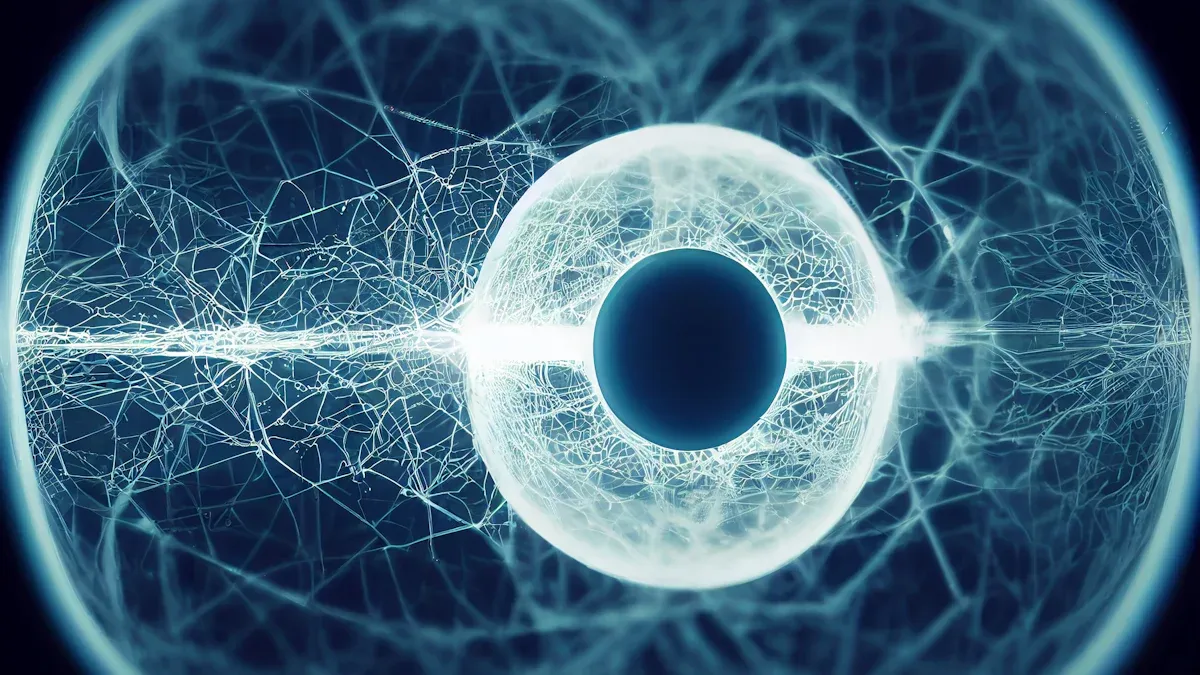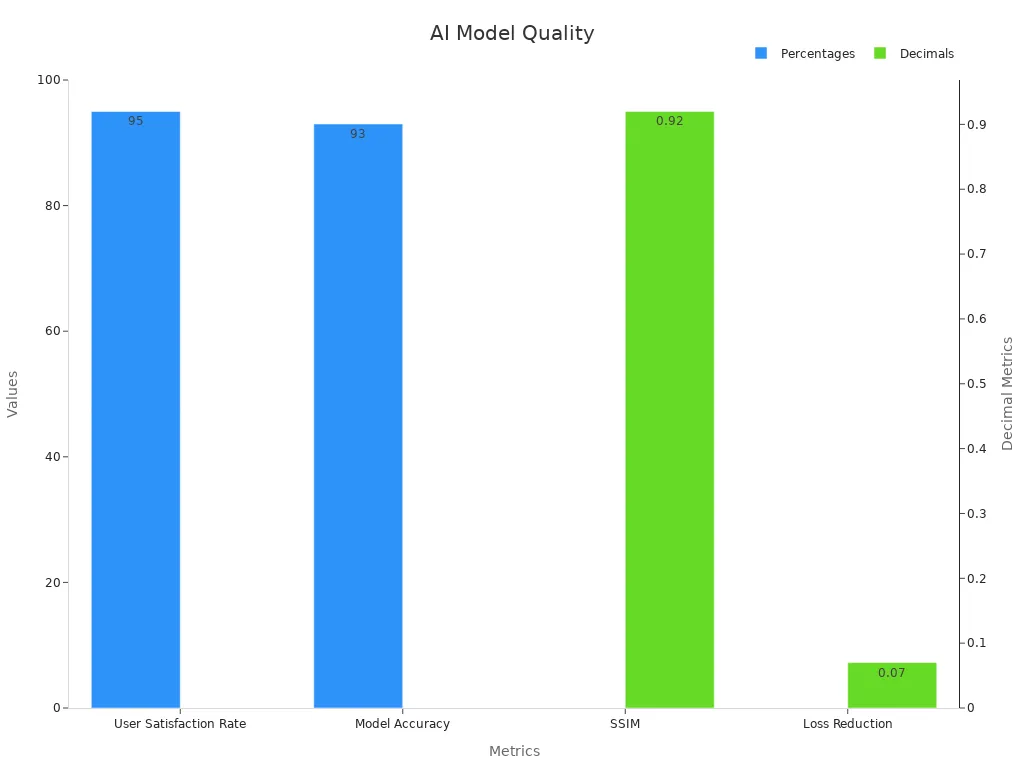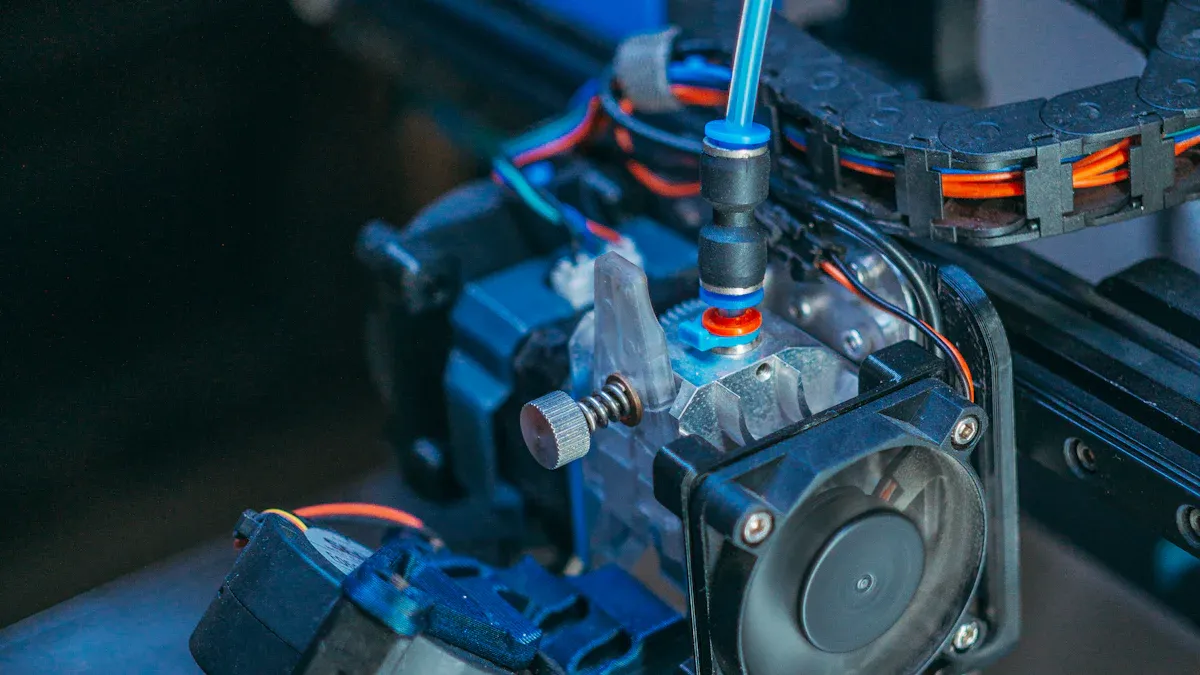
Creating 3D models used to feel like an uphill battle, didn’t it? Long hours, endless tweaking, and complex tools often made it overwhelming. But now, AI has flipped the script. You can generate stunning 3D designs faster than ever. With AI stepping in, tasks that once took hours now happen in minutes. It’s like having a creative partner that handles the heavy lifting, leaving you with more time to focus on your vision. Whether you’re a pro or a beginner, 3D Generation has never been this exciting or accessible.
Key Takeaways
-
AI makes 3D design faster, so models take minutes, not hours. This helps you work more and focus on creative ideas.
-
AI tools let anyone try 3D modeling, no matter their skills. You can make great designs using easy sketches or short text.
-
AI boosts creativity by doing hard tasks for you. This gives you more time to try new ideas and improve your designs.
Core Functionalities of AI in 3D Generation
AI-Powered 3D Model Creation
Imagine sketching a rough idea and watching it transform into a polished 3D model in seconds. That’s the magic of AI-powered 3D model creation. These tools use advanced algorithms to interpret your input—whether it’s a hand-drawn sketch or a basic wireframe—and generate high-quality 3D models. For instance, a prototype using technologies like ControlNet and SDXL has shown how AI can convert low-fidelity user models into high-fidelity 3D designs. This not only saves time but also ensures that your vision comes to life with minimal effort.
Generative AI plays a key role here. It doesn’t just replicate; it innovates. By analyzing patterns and learning from vast datasets, it can create 3D models that are both unique and functional. Whether you’re designing a character for a video game or a prototype for a new product, AI makes the process faster and more intuitive.
Automated Editing and Refinement
Editing used to be a painstaking process, didn’t it? But now, AI takes care of the heavy lifting. Automated editing tools can identify flaws, suggest improvements, and even refine your 3D models without requiring you to lift a finger. These tools analyze your design for symmetry, proportions, and other critical factors, ensuring that your final product is as polished as possible.
Here’s a quick look at how AI-driven tools improve performance during editing and refinement:
|
Metric Type |
Description |
|---|---|
|
Ensures the correctness of annotations and labels in 3D models, improving clarity. |
|
|
Readability Scores |
Assesses how easily the design documentation can be understood by collaborators. |
|
Engagement Metrics |
Measures how effectively the design captures attention, ensuring it meets user expectations. |
With these metrics in mind, it’s clear that AI doesn’t just make editing easier—it makes it smarter.
AI-Assisted Texturing and Rendering
Texturing and rendering are where your 3D models truly come to life. AI-assisted tools simplify this process by automating repetitive tasks and enhancing the quality of textures and lighting. For example, AI can analyze the surface of your model and apply realistic textures that match its geometry. It can also simulate lighting conditions to give your model a lifelike appearance.
The impact of AI on texturing and rendering is backed by impressive metrics:
|
Metric |
Value |
|---|---|
|
User Satisfaction Rate |
95% |
|
Structural Similarity Index (SSIM) |
0.92 |
|
Model Accuracy |
93% |
|
Loss Reduction |
0.07 |

These numbers highlight how AI not only speeds up the process but also elevates the quality of your 3D content creation.
Collaboration and Sharing Features
Collaboration has never been easier, thanks to AI-driven platforms. These tools allow you to work with teams across the globe, sharing ideas and refining designs in real time. Platforms like id8 by Noesis Solutions take this a step further by automating workflows and enabling data-driven decision-making. Here’s how they make a difference:
-
Teams can share knowledge and best practices, fostering innovation.
-
Automated simulation workflows save time and resources.
-
Scalable operations ensure that even large projects run smoothly.
By integrating AI into collaboration tools, you can focus on creativity while the platform handles the logistics. It’s like having a virtual assistant that keeps everyone on the same page.
Benefits of AI in 3D Model Design
Faster Design Processes
Speed is everything when it comes to 3D design, and AI delivers in spades. You no longer have to spend hours tweaking every detail or waiting for rendering processes to finish. AI tools streamline workflows by automating repetitive tasks and optimizing design steps. For example, generative AI can create complex 3D models in seconds, freeing you up to focus on the creative aspects of your project.
Think about it—what used to take days can now be done in minutes. Whether you're designing a game character or prototyping a product, AI ensures that your ideas come to life faster than ever. This speed doesn’t just save time; it also boosts productivity, allowing you to complete more projects in less time.
Tip: Use AI-powered platforms to automate time-consuming tasks like rendering and texturing. You'll be amazed at how much faster your workflow becomes.
Accessibility for All Skill Levels
AI is breaking down barriers in 3D generation, making it accessible to everyone, regardless of skill level. You don’t need to be a seasoned designer to create stunning 3D models anymore. Tools powered by generative AI simplify the process, allowing beginners to generate game-ready models from simple text prompts.
Here’s why accessibility is skyrocketing:
-
Generative AI technologies make creating, editing, and sharing 3D models easier than ever.
-
Platforms are being developed with the mission to unlock 1 billion 3D creators worldwide.
-
Non-experts can now produce professional-quality designs without extensive training.
This shift is transforming the industry. Whether you’re a hobbyist or a professional, AI ensures that you can dive into 3D modeling without feeling overwhelmed.
Enhanced Creativity and Innovation
AI doesn’t just speed things up—it amplifies your creativity. By handling the technical heavy lifting, AI gives you more room to experiment and innovate. Imagine having a tool that suggests design variations or generates textures you hadn’t even considered. That’s the kind of creative boost AI brings to the table.
Generative AI analyzes vast datasets to inspire new ideas and push boundaries. It’s like having a brainstorming partner that never runs out of suggestions. Whether you’re designing architectural models or crafting characters for a video game, AI helps you think outside the box and create something truly unique.
Callout: Creativity thrives when you’re not bogged down by technical details. Let AI handle the grunt work so you can focus on your vision.
Cost-Effectiveness for Businesses
AI isn’t just a creative powerhouse—it’s also a financial game-changer. For businesses, the cost savings are staggering. Generative AI reduces the expense of creating complex 3D models by automating processes that would otherwise require skilled designers.
Here’s the math: generating an image with AI costs about $0.001 and takes just one second. Compare that to hiring a designer, which could cost hundreds of dollars and take days. AI is up to 100,000 times cheaper and 3,600 times faster than traditional methods. This makes it an invaluable tool for businesses looking to cut costs without sacrificing quality.
By adopting AI-driven tools, companies can allocate resources more efficiently, scale their operations, and stay competitive in a fast-paced market. Whether you’re in game development, product design, or architecture, AI ensures you get the most bang for your buck.
Challenges in AI-Driven 3D Generation
Dependence on High-Quality Input Data
AI thrives on data, but when it comes to 3d modeling, the quality of input data can make or break the results. Many AI tools struggle with data scarcity, integration issues, and quality inconsistencies. For example, combining diverse datasets often leads to mismatched textures or incomplete models. Here's a quick breakdown of the challenges:
|
Challenge Type |
Description |
|---|---|
|
Data Scarcity |
Significant progress has been made, but data scarcity persists in 3D generation. |
|
Integration Issues |
The integration of diverse data sources is a major challenge for AI models. |
|
Quality Issues |
Ensuring the accuracy and completeness of data sets is critical for effective AI-driven models. |
Without high-quality datasets, AI tools may produce 3d models that lack precision or realism, leaving you with more work to fix errors.
Limited Customization for Complex Designs
AI excels at generating basic 3d models, but it often falls short when dealing with intricate designs. Tasks like creating movable lamps or thumb splints require a deep understanding of structural integrity, which AI alone cannot provide. Here are some common limitations:
-
AI-generated models often lack precision for complex geometric forms.
-
High-resolution textures and fine details still require human intervention.
-
Balancing aesthetics with functionality remains a challenge for AI tools.
While AI can reduce modeling time by up to 40%, you’ll still need to step in for high-level customizations.
Ethical and Intellectual Property Concerns
AI-driven 3d generation raises questions about ownership and originality. Who owns the rights to an AI-generated model? And how do you ensure that the AI isn’t unintentionally copying existing designs? These concerns can complicate the adoption of AI tools, especially in industries like gaming and architecture.
Learning Curve for Advanced Features
AI design software often comes with advanced features, but mastering them isn’t always easy. Many users report a steep learning curve, particularly non-technical creators. Navigating these tools can feel overwhelming, especially when integration issues or high costs come into play. If you’re new to 3d modeling, you might find yourself spending more time learning the software than creating designs.
Real-World Applications of AI in 3D Modeling

Game Development and Animation
AI is transforming game development and animation by making the creation of 3D models faster and more efficient. Studios now use AI tools to generate characters, environments, and even animations with minimal effort. Nearly 73% of studios already rely on AI, and 88% plan to adopt it soon. Productivity gains of over 20% have been reported by 40% of studios, while 25% have seen costs drop by more than 20%.
Ubisoft’s Ghostwriter tool is a great example of how AI enhances workflows. It helps scriptwriters create multiple variations of NPC dialogue quickly, allowing for richer, more immersive worlds. With AI handling repetitive tasks, you can focus on crafting unique gameplay experiences that captivate players.
Product Design and Prototyping
AI simplifies product design by automating the creation of 3D models for prototypes. You can sketch an idea, and AI tools will turn it into a detailed model in seconds. This speeds up the design process and reduces costs, making it easier to iterate and refine your concepts.
For businesses, AI-driven prototyping is a game-changer. It allows you to test designs quickly, identify flaws, and make adjustments without wasting resources. Whether you’re designing consumer goods or industrial equipment, AI ensures your prototypes are accurate and ready for production.
Architecture and Urban Planning
Urban planning and architecture benefit immensely from AI-powered 3D modeling tools. These tools help you design sustainable cities and buildings while optimizing layouts for functionality and aesthetics.
|
Tool Name |
Description |
Key Features |
|---|---|---|
|
Configures urban layouts for large-scale developments. |
Incorporates functional, environmental, and socio-economic indicators for sustainability. |
|
|
Digital Blue Foam |
Supports generative design and spatial analytics for urban planning. |
Reduces costs, minimizes emissions, and integrates with existing software. |
|
CityEngine |
3D modeling software for large-scale urban environments. |
Real-time editing, scenario visualization, and zoning compliance with GIS data integration. |
Tools like CITYPLAIN and CityEngine make it easier to visualize urban spaces and ensure compliance with zoning regulations. You can create realistic 3D models of entire neighborhoods, reducing costs and improving efficiency.
Medical and Scientific Visualization
AI is revolutionizing medical and scientific visualization by creating highly detailed 3D models of organs, cells, and other biological structures. These models help researchers and doctors understand complex systems and plan treatments more effectively.
For example, AI can generate 3D models of a patient’s anatomy from MRI or CT scans, enabling surgeons to practice procedures before entering the operating room. In scientific research, AI-driven modeling tools allow you to visualize molecular structures and simulate interactions, accelerating discoveries in fields like pharmacology and genetics.
The Future of AI in 3D Generation by 2025
Advancements in Generative AI
Generative AI is evolving at lightning speed, and by 2025, it’s set to redefine how you approach 3D generation. Imagine tools that not only create models but also predict design trends and suggest improvements in real time. With a projected annual growth rate of 46%, generative AI is becoming a cornerstone of industries worldwide. Businesses are investing heavily, with average funding for generative AI initiatives expected to hit $110 million by 2024.
This growth isn’t just about numbers. It’s about possibilities. Generative AI will empower you to create 3D models faster, with greater precision and creativity. Whether you’re designing for gaming, architecture, or product prototyping, these advancements will make your workflow smoother and more intuitive.
|
Statistic Description |
Value |
Year |
|---|---|---|
|
Cumulative global economic impact of AI adoption |
$19.9 trillion |
2030 |
|
Gen AI market growth rate |
46% annually |
2030 |
|
Percentage of organizations increasing investments |
67% |
Last year |
|
Potential cost savings for businesses adopting Gen AI |
15.2% |
N/A |
Integration with AR/VR and Metaverse
The fusion of AI with AR, VR, and the metaverse is transforming 3D generation into an immersive experience. Picture this: you’re designing a 3D model, and AI-powered AR lets you visualize it in your physical space in real time. Or, imagine creating virtual worlds where AI adapts environments dynamically based on user behavior. These integrations are reshaping how you interact with 3D models, making the process more engaging and intuitive.
|
Trend Description |
Implication |
|---|---|
|
Integration of AR with AI, IoT, and 5G |
Creates immersive, intuitive, and highly interactive design experiences. |
|
AI-driven AR personalization |
Enhances user engagement by tailoring content in real-time based on behavior. |
|
Creates personalized and intuitive user experiences by adapting environments. |
|
|
Dynamic and responsive virtual worlds |
Marks a significant shift in the future of virtual reality. |
This convergence of technologies will revolutionize industries like gaming, architecture, and education, giving you tools to create like never before.
No-Code Platforms for Accessibility
By 2025, no-code platforms will make 3D generation accessible to everyone, regardless of technical expertise. These platforms let you create professional-quality 3D models using simple drag-and-drop interfaces or even text prompts. You won’t need to learn complex software or coding. Just focus on your ideas, and let the platform handle the rest.
This shift is democratizing 3D generative AI. It’s opening doors for hobbyists, students, and small businesses to compete with industry giants. Whether you’re a beginner or a seasoned designer, no-code platforms will empower you to bring your vision to life effortlessly.
Tip: Explore no-code tools to experiment with 3D design. They’re perfect for quick prototyping and creative brainstorming.
Cloud-Based Collaboration Tools
Cloud-based tools are revolutionizing how teams collaborate on AI-assisted 3D projects. These platforms allow you to work with others in real time, no matter where they are. Tools like Specter and Snaptrude integrate features like task tracking and real-time updates, ensuring your projects stay on schedule. AI also automates repetitive tasks, streamlines resource allocation, and identifies bottlenecks early.
|
Tool |
Benefit |
Source |
|---|---|---|
|
Specter |
Integrates real-time updates and task tracking linked to BIM models. |
|
|
Snaptrude |
Facilitates real-time collaboration for tracking progress and updates. |
With these tools, you’ll save time, reduce errors, and enhance communication. Collaboration has never been this seamless or efficient.
AI is reshaping how you approach 3D design. It speeds up workflows, boosts creativity, and makes tools accessible to everyone. By 2025, AI will unlock even more possibilities. From sustainable architecture to innovative sculptures, it’s clear that AI is transforming 3D modeling into a faster, smarter, and more exciting process.
Note: The collaboration between human creativity and AI leads to unique designs and improved precision, proving its transformative impact on 3D design.
FAQ
What is AI-driven 3D modeling?
AI-driven 3D modeling uses artificial intelligence to automate tasks like design, texturing, and rendering. It simplifies workflows and makes creating 3D models faster and easier.
Can beginners use AI tools for 3D design?
Absolutely! AI tools are beginner-friendly. They let you create professional-quality 3D models using simple inputs like sketches or text prompts, no prior experience required.
How does AI improve 3D rendering?
AI enhances 3D rendering by automating lighting, textures, and shadows. It ensures your models look realistic while saving you time and effort.







